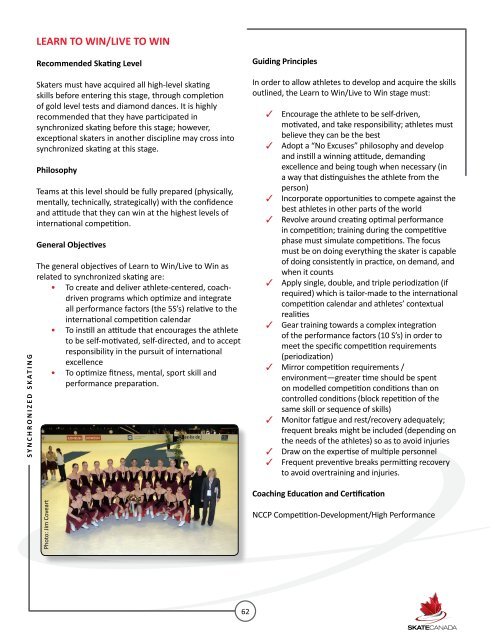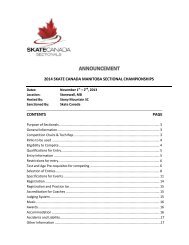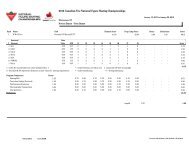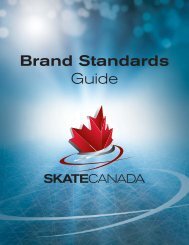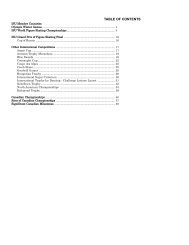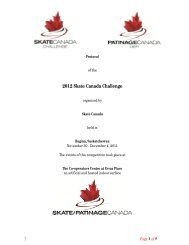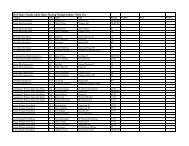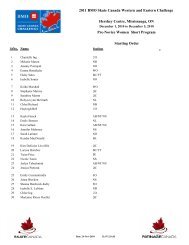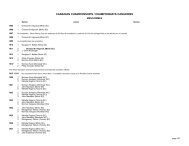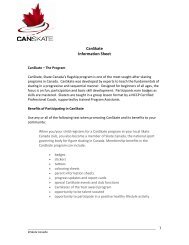LONG-TERM ATHLETE DEVELOPMENT - Skate Canada
LONG-TERM ATHLETE DEVELOPMENT - Skate Canada
LONG-TERM ATHLETE DEVELOPMENT - Skate Canada
You also want an ePaper? Increase the reach of your titles
YUMPU automatically turns print PDFs into web optimized ePapers that Google loves.
S Y N C H R O N I Z E D S K A T I N G<br />
LEARN TO WIN/LIVE TO WIN<br />
Recommended Skating Level<br />
<strong>Skate</strong>rs must have acquired all high-level skating<br />
skills before entering this stage, through completion<br />
of gold level tests and diamond dances. It is highly<br />
recommended that they have participated in<br />
synchronized skating before this stage; however,<br />
exceptional skaters in another discipline may cross into<br />
synchronized skating at this stage.<br />
Philosophy<br />
Teams at this level should be fully prepared (physically,<br />
mentally, technically, strategically) with the confidence<br />
and attitude that they can win at the highest levels of<br />
international competition.<br />
General Objectives<br />
The general objectives of Learn to Win/Live to Win as<br />
related to synchronized skating are:<br />
• To create and deliver athlete-centered, coachdriven<br />
programs which optimize and integrate<br />
all performance factors (the 5S’s) relative to the<br />
international competition calendar<br />
• To instill an attitude that encourages the athlete<br />
to be self-motivated, self-directed, and to accept<br />
responsibility in the pursuit of international<br />
excellence<br />
• To optimize fitness, mental, sport skill and<br />
performance preparation.<br />
Photo: Jim Coveart<br />
865 Sheord Road, Ottawa, Ontario K1J 1H9<br />
Phone 613.747.1007 I Toll Free 1.888.747.2372 I Fax 613.748.5718 I Toll Free Fax 1.877.211.2372<br />
62<br />
Guiding Principles<br />
In order to allow athletes to develop and acquire the skills<br />
outlined, the Learn to Win/Live to Win stage must:<br />
3 Encourage the athlete to be self-driven,<br />
motivated, and take responsibility; athletes must<br />
believe they can be the best<br />
3 Adopt a “No Excuses” philosophy and develop<br />
and instill a winning attitude, demanding<br />
excellence and being tough when necessary (in<br />
a way that distinguishes the athlete from the<br />
person)<br />
3 Incorporate opportunities to compete against the<br />
best athletes in other parts of the world<br />
3 Revolve around creating optimal performance<br />
in competition; training during the competitive<br />
phase must simulate competitions. The focus<br />
must be on doing everything the skater is capable<br />
of doing consistently in practice, on demand, and<br />
when it counts<br />
3 Apply single, double, and triple periodization (if<br />
required) which is tailor-made to the international<br />
competition calendar and athletes’ contextual<br />
realities<br />
3 Gear training towards a complex integration<br />
of the performance factors (10 S’s) in order to<br />
meet the specific competition requirements<br />
(periodization)<br />
3 Mirror competition requirements /<br />
environment—greater time should be spent<br />
on modelled competition conditions than on<br />
controlled conditions (block repetition of the<br />
same skill or sequence of skills)<br />
3 Monitor fatigue and rest/recovery adequately;<br />
frequent breaks might be included (depending on<br />
the needs of the athletes) so as to avoid injuries<br />
3 Draw on the expertise of multiple personnel<br />
3 Frequent preventive breaks permitting recovery<br />
to avoid overtraining and injuries.<br />
Coaching Education and Certification<br />
NCCP Competition-Development/High Performance


